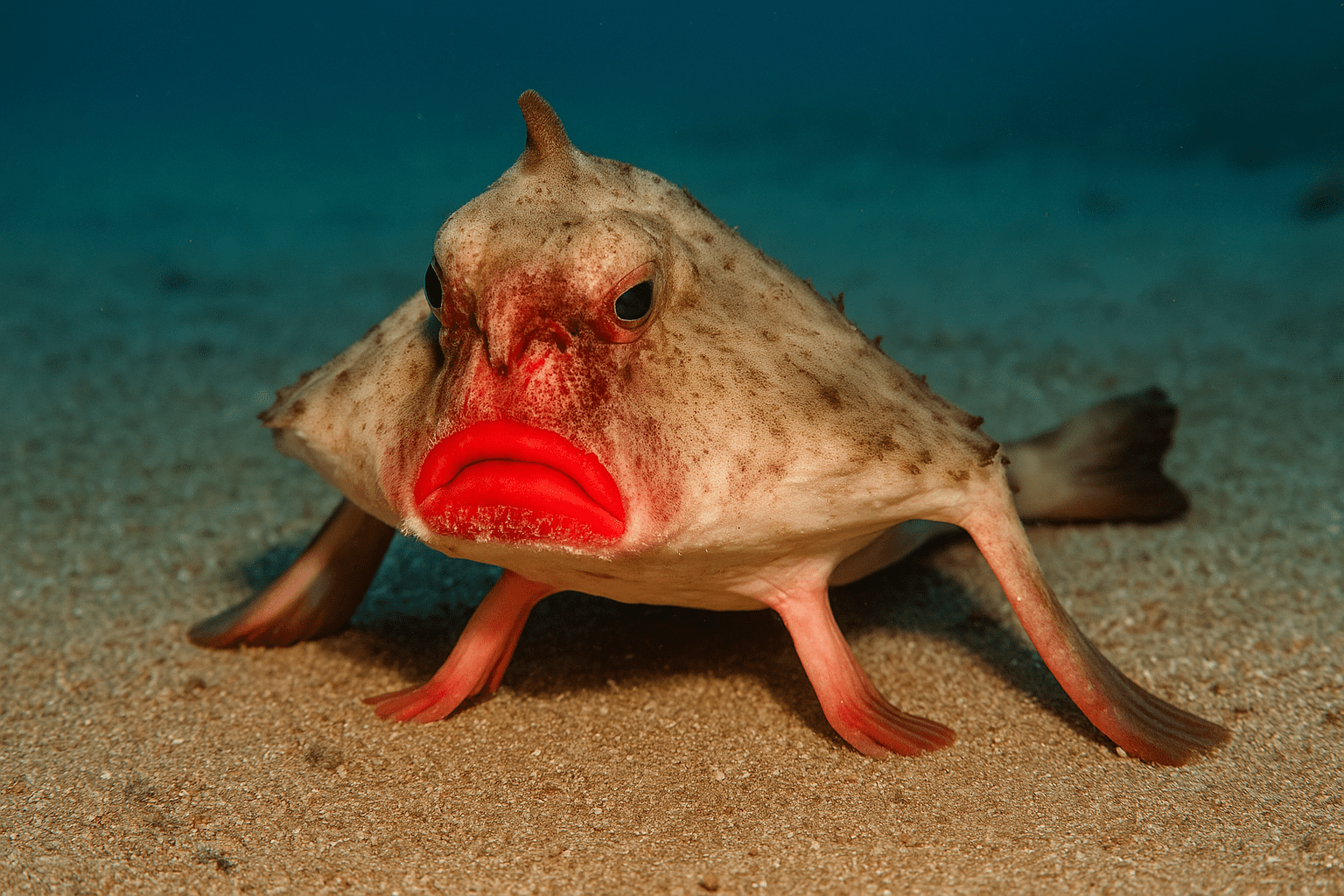
The ocean is filled with extraordinary creatures, each more fascinating than the last. Among these, the Red-lipped batfish (Ogcocephalus darwini) stands out for its peculiar appearance and strange behaviors. Native to the waters around the Galápagos Islands, this unusual fish is not only a marvel of evolutionary adaptation but also a vivid example of the weird and wonderful biodiversity found in our oceans. With its bright red lips and unusual method of locomotion, the Red-lipped batfish is a creature that captures the imagination of marine biologists and nature enthusiasts alike.
The Unique Appearance of the Red-Lipped Batfish
One of the most striking features of the Red-lipped batfish is, as its name suggests, its vividly colored lips. These bright red lips are believed to play a role in species recognition and possibly in attracting mates. Unlike many other fish, the batfish does not rely on swimming to move around. Instead, it uses its pectoral fins, which are modified to act like legs, allowing it to “walk” along the ocean floor.
The body of the Red-lipped batfish is flattened and disc-shaped, which aids in its bottom-dwelling lifestyle. Its skin is rough and covered in small, scale-like structures, giving it a somewhat sandpapery texture. This fish also has a peculiar structure on its head known as the illicium, which is a modified dorsal fin that resembles a small fishing rod. This feature is used to lure prey closer, much like the anglerfish, although it is not as well developed in the batfish.
In addition to its lips and body shape, the batfish has a color pattern that provides excellent camouflage against the ocean floor. Its body is generally brown or gray, blending in with the sand and rocks. However, its lips remain a startling contrast, making it one of the most easily recognizable fish in its habitat.
Where the Red-Lipped Batfish Calls Home
The natural habitat of the red-lipped batfish is as interesting as the fish itself. It lives primarily around the Galápagos Islands and occasionally off the coast of Peru. These regions provide the perfect mix of rocky bottoms and sandy seafloors that the batfish loves to explore.
Typically, you’ll find this species at depths of 30 to 100 meters (about 100 to 330 feet). It prefers cooler, deeper waters where it can move about without worrying much about predators. Because it’s not a strong swimmer, staying near the bottom is essential for its safety.
Despite its somewhat bizarre look, the red-lipped batfish plays an important role in the ecosystem. It helps control small invertebrate populations like worms, crustaceans, and mollusks, keeping the delicate ocean floor balance in check. It’s proof that even the strangest-looking animals have an important job to do in nature.
The Mystery Behind Those Bright Red Lips
One of the most iconic features of the red-lipped batfish is, of course, its lips. Their fiery red color has puzzled scientists and fascinated divers for years. Why would a bottom-dwelling fish need such a bold look?
The leading theory is sexual selection — meaning the lips help attract mates. Just as some birds have colorful feathers, the batfish may use its lips to signal health and strength. A brighter, more vibrant red could mean a more desirable mate.
Another possible reason is species recognition. In the deep sea, visibility is limited. Those bright lips could help batfish tell each other apart during mating season or social interactions. Some experts also suggest that the red coloration could serve as a distraction for predators, drawing attention away from more vulnerable body parts.
No matter the reason, those lips have become a symbol of oceanic oddities and are one of the most photographed features in marine biology. If there were an underwater beauty contest, the red-lipped batfish would definitely win “Best Makeup.”
The Batfish’s Bizarre Behavior
The Red-lipped batfish exhibits several behaviors that set it apart from other marine species. Its unique method of locomotion is one of the most noticeable. Instead of swimming like most fish, the batfish uses its adapted fins to walk along the seafloor. This walking motion is not particularly fast, but it is effective for a bottom-dweller that relies on stealth to capture prey.
This species is also known for its solitary nature. Unlike many fish that travel in schools, the Red-lipped batfish prefers to live and hunt alone. It is primarily a nocturnal hunter, using the cover of darkness to ambush small fish and invertebrates. The illicium on its head can be used to attract prey, though it is not as prominent as in other anglerfish species. This unique hunting strategy, combined with its ability to blend into the environment, makes the batfish a successful predator in its niche.
The diet of the Red-lipped batfish consists mainly of small fish, crustaceans, and mollusks. It uses its sharp, pointed teeth to grasp and consume its prey. Despite its somewhat ungainly appearance, the batfish is a skilled hunter, capable of catching quick-moving prey with surprising efficiency.
The Fish That Walks Instead of Swims
Unlike most fish that glide through the water, the red-lipped batfish is better known for its walking behavior. Its fins are specially adapted to function like small legs, allowing it to move slowly across the seabed. This unique adaptation has earned it the nickname “the walking fish.”
The batfish’s body shape is also designed for this kind of movement. Its flattened body and wide pectoral fins give it excellent stability while walking, helping it to stay close to the ocean floor. Instead of wasting energy swimming against currents, it prefers to shuffle along and look for small prey hiding in the sand.
Although it can swim short distances if necessary, it does so awkwardly. Its movements in the water are slow and clumsy, so walking is its preferred mode of travel. This quirky behavior not only makes it fascinating to watch but also shows how wonderfully adaptable marine life can be.
Diet and Daily Life of the Red-Lipped Batfish
The diet of the red-lipped batfish mainly consists of small sea creatures that live near the ocean floor. It feeds on crustaceans, mollusks, small fish, and worms. Using its clever head lure, it can attract unsuspecting prey right to its mouth.
During the day, the batfish often rests or slowly wanders around looking for food. Because it’s not a fast swimmer, it relies more on patience and camouflage than speed. Its sandy-colored body blends well with the ocean floor, helping it stay hidden from both prey and predators.
Interestingly, the red-lipped batfish is generally a solitary creature. It spends most of its time alone, except during mating season. Scientists still don’t know much about how it reproduces, but like many deep-sea fish, it likely lays eggs that drift with the current until the young hatch and settle to the bottom.
Habitat and Distribution of the Red-Lipped Batfish
The Red-lipped batfish is endemic to the Galápagos Islands, a group of volcanic islands in the Pacific Ocean known for their unique wildlife. This fish is typically found at depths of 10 to 150 meters, where it inhabits sandy or rocky bottoms. The waters around the Galápagos are rich in nutrients, supporting a diverse array of marine life, including the batfish.
The environment in which the batfish lives is characterized by its strong currents and varying temperatures, influenced by the mixing of warm and cold oceanic waters. This creates a dynamic and challenging habitat that has shaped the evolution of many species in the region, including the Red-lipped batfish. The fish is well adapted to life in these conditions, with its ability to walk on the seafloor providing a distinct advantage in navigating the complex underwater terrain.
The distribution of the Red-lipped batfish is relatively limited compared to other marine species. It is not found outside of the Galápagos Islands, making it a species of interest for conservationists. The unique environment of the Galápagos is essential to the survival of this fish, and any changes to this habitat could have significant impacts on its population.
Conservation Status and Human Interaction
Currently, the Red-lipped batfish is not listed as endangered or vulnerable, but its restricted range makes it susceptible to environmental changes. The Galápagos Islands are a protected area, and efforts are made to preserve the unique ecosystems found there. However, human activities such as tourism, fishing, and climate change pose potential threats to the delicate balance of life in these waters.
Tourism in the Galápagos is a double-edged sword. While it brings attention to the need for conservation and provides funding for protection efforts, it also increases the risk of environmental degradation. Pollution, habitat destruction, and the introduction of invasive species are all concerns associated with increased human presence in the area. For the Red-lipped batfish, maintaining the health of its habitat is crucial for its continued survival.
Fishing, both legal and illegal, also poses a threat to the marine life of the Galápagos. Although the Red-lipped batfish is not a target species for fisheries, it can be affected by bycatch and habitat destruction caused by fishing activities. Conservation efforts in the region focus on sustainable practices and the enforcement of regulations to minimize the impact on the ecosystem.
Climate change is perhaps the most significant long-term threat to the Red-lipped batfish. Changes in ocean temperature and chemistry could alter the delicate balance of the Galápagos marine environment, potentially affecting the availability of prey and the suitability of the batfish’s habitat. Ongoing research and monitoring are essential to understand the potential impacts of climate change on this unique species and to develop strategies for its protection.
In conclusion, the Red-lipped batfish is a remarkable example of the diversity and adaptability of life in the ocean. Its unique appearance, bizarre behavior, and specialized habitat make it a fascinating subject for study and a symbol of the need to protect our planet’s most unique ecosystems. By understanding and preserving the environment in which it lives, we can ensure that this weird and wonderful creature continues to thrive for generations to come.








